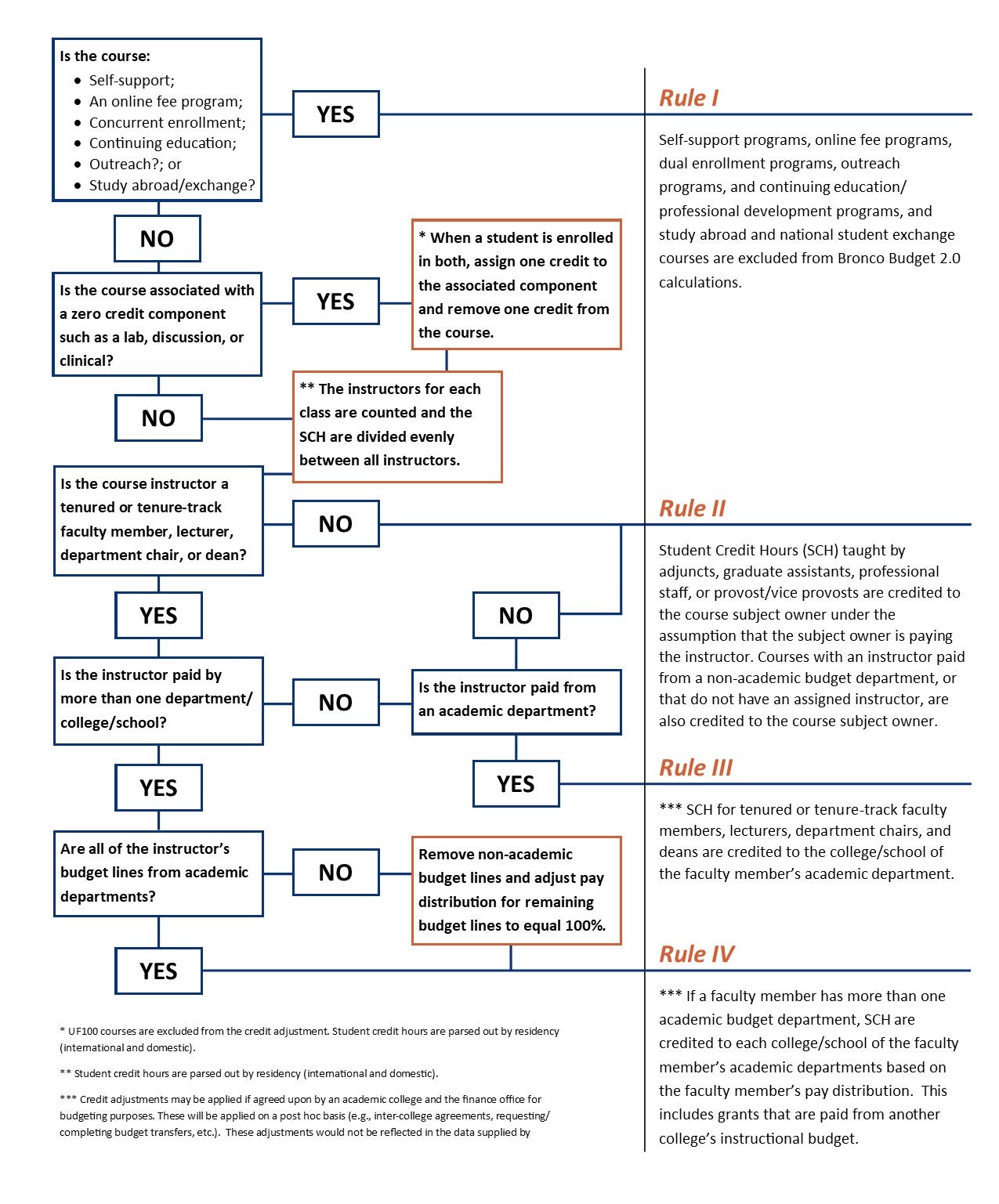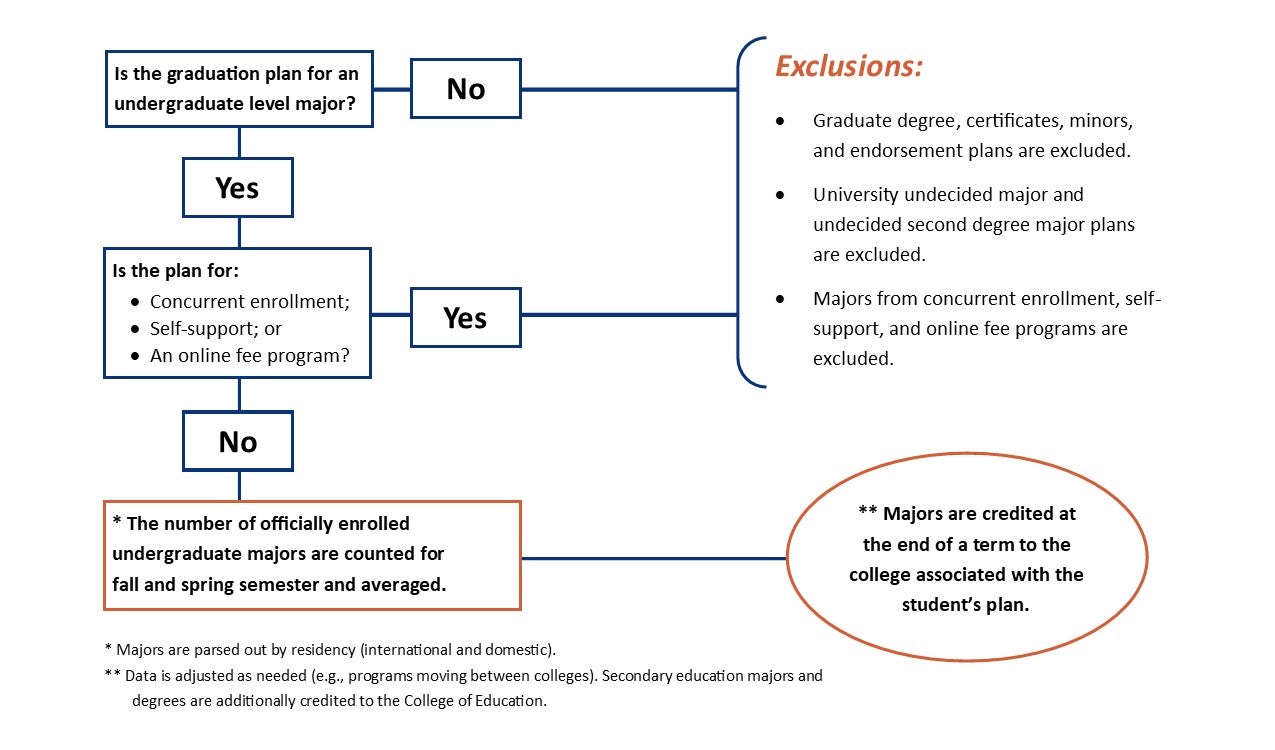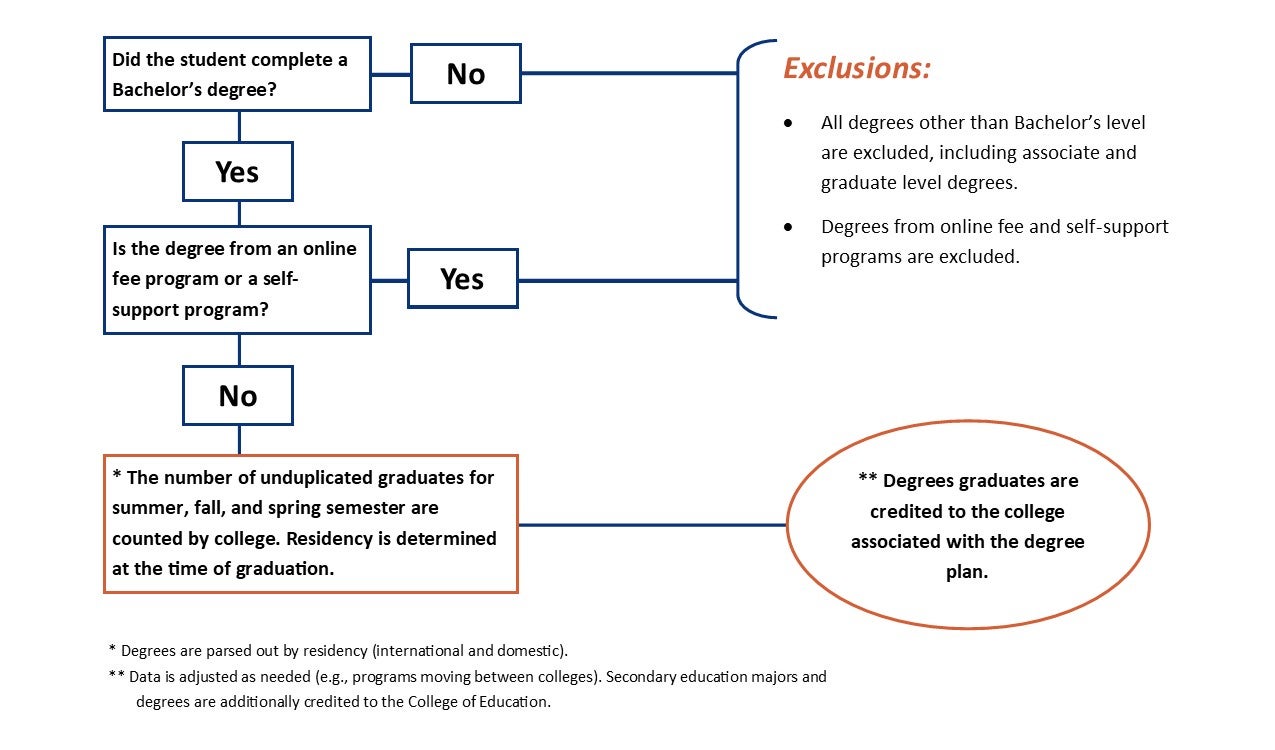Bronco Budget 2.0 Measures Data Glossary
| Term | Definition |
|---|---|
| Year | Summer, Fall, and Spring terms (leading summer) Summer excluded from SCH & Majors, and included in Graduates. |
| Academic Revenue Units | College in which the instructor is employed (for student credit hours) or that is the plan owner in the case of majors and degrees |
| Measure 1 Undergraduate Student Credit Hours (SCH) | Total credits attempted for load, End-of-Term. Determined by level of the course, not the student. Credits follow instructor: credits are assigned to college who is paying the instructor. For instructors paid by multiple departments, a credit distribution procedure is applied. See technical notes document for complete logic, including exclusions for alternative funding programs. |
| Measure 2 Undergraduate Majors | Average number of degree-seeking majors (fall and spring) based on the college that is the plan owner of the plans/majors in which students are enrolled. Students in secondary education programs also are credited to the College of Education. Counts majors only and excludes certificates, minors, and endorsements. Based on End-of Term distinct headcount of students Officially Enrolled. |
| Measure 3 Undergraduate Degree Graduates | Annual number of students completing a bachelor’s degree program. Annual timeframe includes Summer, Fall, and Spring as is consistent with Federal and other external reporting. Totals are unduplicated at the college level, and students completing awards in two or more colleges are counted once in each of the colleges. Students in secondary education programs also are credited to the College of Education. See technical notes document for complete logic, including exclusions for alternative funding programs. |
| Measure 4 Graduate SCH | Total credits attempted for load; End-of-Term. Determined based on level of the course, not the student. Credits follow instructor; credits are assigned to college who is paying the instructor. For instructors paid by multiple departments, a credit distribution procedure is applied. See SCH section for complete logic, including exclusions for alternative funding programs. |
| Residency | Domestic students (residents and nonresidents) are separated from International students in the model. International students are defined as citizenship = Foreign (also IPEDS ethnicity = nonresident alien).
|
You can print the Flowcharts listed below here (PDF)
Students Credit Hour (SCH) Decision Tree

Majors Flowchart

Degree Graduates Flowchart

Text Version
Student Credit Hour (SCH) Process Outline
- Is the course self-support; an online fee program; concurrent enrollment; continuing education; outreach; or Study Abroad/National Student Exchange?
- If yes, see rule I below.
- If no, continue to question 2.
- Is the course associated with a zero credit component such as a lab, discussion, or clinical?
- *If yes, when a student is enrolled in both, one credit is assigned to the associated component and one credit is removed from the course. Then, instructors for each class are counted and the SCH are divided evenly between all instructors. Continue to question 3.
- **If no, instructors for each class are counted and the SCH are divided evenly between all instructors. Continue to question 3.
- Is the course instructor a tenured or tenure-track faculty member, lecturer, department chair, or dean?
- If yes, continue to question 4.
- If no, see rule II below.
- Is the instructor paid by more than one department/college/school?
- If yes, continue to question 5.
- If no, is the instructor paid from an academic department?
- If yes, see rule III below.
- If no, see rule II below.
- Are all of the instructor’s budget lines from academic departments?
- If yes, see rule IV below.
- If no, non-academic budget lines are removed and the pay distribution for remaining budget lines is adjusted to equal 100%. Then, see rule IV below.
Rule I
Self-support programs, online fee programs, dual enrollment programs, outreach programs, continuing education/professional development programs, and study abroad and national student exchange courses are excluded from Bronco Budget 2.0 calculations.
Rule II
Student Credit Hours (SCH) taught by adjuncts, graduate assistants, professional staff, or provost/vice provosts are credited to the course subject owner under the assumption that the subject owner is paying the instructor. Courses with an instructor paid from a non-academic budget department, or that do not have an assigned instructor, are also credited to the course subject owner.
Rule III
***SCH for tenured or tenure-track faculty members, lecturers, department chairs, and deans are credited to the college/school of the faculty member’s academic department.
Rule IV
***If a faculty member has more than one academic budget department, SCH are credited to each college/school of the faculty member’s academic departments based on the faculty member’s pay distribution. This includes grants that are paid from another college’s instructional budget.
*UF 100 courses are excluded from the credit adjustment. Student credit hours are parsed out by residency (international and domestic).
** Student credit hours are parsed out by residency (international and domestic).
*** Credit adjustments may be applied if agreed upon by an academic college and the finance office for budgeting purposes. These will be applied on a post hoc basis (e.g., inter-college agreements, requesting/completing budget transfers, etc.). These adjustments would not be reflected in the data supplied by Institutional Effectiveness.
Majors Process Outline
- Is the student’s graduation plan for an undergraduate level major?
- If yes, continue to question 2.
- If no, see exclusions list below.
- Is the graduation plan for: concurrent enrollment; self-support; or an online fee program?
- If yes, see exclusions list below.
- If no, the number of officially enrolled undergraduate majors are counted for fall and spring semester and averaged. Majors are credited at the end of a term to the college associated with the student’s plan.
Exclusions:
- Graduate degree, certificates, minors, and endorsement plans are excluded.
- University undecided major and undecided second degree major plans are excluded.
- Majors from concurrent enrollment, self-support, and online fee programs are excluded.
Degree Graduates Process Outline
- Did the student complete a Bachelor’s degree?
- If yes, continue to question 2.
- If no, see exclusions list below.
- Is the degree from an online fee program or a self-support program?
- If yes, see exclusions list below.
- If no, the number of unduplicated graduates for summer, fall, and spring semester are counted by college. Residency is determined at the time of graduation. Degrees graduates are credited to the college associated with the degree plan.
Exclusions:
- All degrees other than Bachelor’s level are excluded, including associate and graduate level degrees.
- Degrees from online fee and self-support programs are excluded.
* Majors and degrees are parsed out by residency (international and domestic).
** Data is adjusted as needed (e.g., programs moving between colleges). Secondary education majors and degrees are additionally credited to the College of Education.